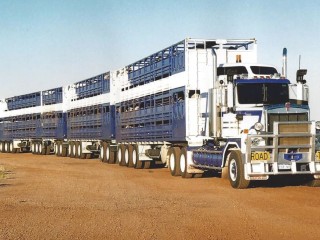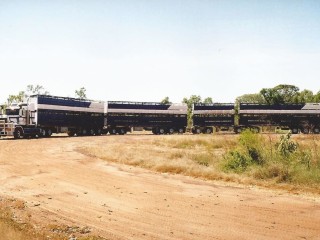The six-deck triple road train epitomises the scale and vastness of Australia’s northern cattle industry, but in recent years even larger four-trailer combinations have been adopted as transport operators search for greater efficiencies.
 In simple terms, the more cattle a single prime mover can pull within maximum allowable length limits and in keeping with animal welfare and road safety standards, the more efficient its operation can be.
In simple terms, the more cattle a single prime mover can pull within maximum allowable length limits and in keeping with animal welfare and road safety standards, the more efficient its operation can be.
The most common long-distance configurations used in the north are six-deck triple road-trains and the B-Double and dog-trailer combination, but now four-trailer configurations which can add a full extra deck within the 53.5m road train limit are also increasingly on the move across the north.
One man who has been at the forefront of developing seven deck units is WA transporter John Leeds from Leeds Transport at Bullsbrook north of Perth.
Mr Leeds and his son Justin were driving a triple road-train back from Queensland in the 1990s when they began tossing around the idea of adding a fourth trailer to shift more cattle.
“The idea was brought about by the need to shift a lot of cattle in a hurry when we were doing boats out of the Pilbara,” Mr Leeds explained.
“When you load boats out of Port Hedland, and there were a lot in those days, you’ve got to bring trucks 1800km from Perth to the boat. We figured that if we could use seven-deck units with each prime mover, we could load each boat far more quickly.
“When you’re loading a boat of 5000 cattle, every time three seven-deck units load up they are basically able to put on 1000 at a time.”
With the help of their good friend the late Dennis Buntine, the oldest son of NT livestock transport pioneer Noel Buntine and the owner of Territory Transport Sales and Victoria River Transport, the Leeds began designing a combination capable of incorporating a full seven decks within the 53.5m limit.
Their first design, devised with the help of Bernie Brock who worked with Dennis Buntine at Territory Transport Sales, came in at 55m.
“We went to the Department of Main Roads here in WA and asked for a 55m permit, and they said ‘if it can’t be built inside 53.5m, you can’t have it’,” John recalled.
While the initial design would have squeezed within the 53.5m limit if pulled by cab-over prime mover, Mr Leeds wanted a bonneted truck to pull the configuration for purposes of driver comfort on long distances and to maximise the amount of fuel each road train could carry.
So they went back to the drawing board to trim a further 1.5m from the design, which involved adjusting axle groupings and trimming the A-trailer of the B-Double component to three-metres.
When the day of judgement came, and they presented their first purpose-built, four-trailer, seven-deck unit to the WA Department of Main Roads for measurement, it came in under the 53.5m limit with 600mm to spare, and that was including a 6.2m wheel-base bonneted prime mover.
 The Leeds’ seven-deck unit effectively takes the form of two dog trailers and a B-Double.
The Leeds’ seven-deck unit effectively takes the form of two dog trailers and a B-Double.
Three of the trailers in the configuration are 12.2 metres long each, matching the 40 foot length of a traditional deck and providing two decks per trailer, while the shorter trailer of the B-Double component constitutes a single deck.
Mr Leeds said the configuration effectively means his drivers can cart an extra deck of cattle with every prime mover. Or, put another way, they can carry the same number of cattle with six prime movers that it would normally take seven triple-road trains to move.
“They shift a lot of cattle,” he said.
The seven-deck units have a gross weight when fully loaded of up to 135t. For the 14 years the units have been in use by Leeds Transport they have been comfortably pulled by prime movers rated at 140t.
Mr Leeds said the additional deck did not add significantly to fuel consumption. “These fuel guzzling trucks now don’t use much more fuel to pull a seven than they do to pull a six.”
His advice is that the units are best operated in a total purpose-built configuration, rather than being put together by mixing and matching existing trailers and dollies.
From a physical handling perspective, Mr Leeds said the configuration was very stable, but it was important in his view that it be assembled with the two dog trailers hitched at the front and the B-Double at the rear.
“In my opinion the B-Double is better at the back, that is where it tows best,” Mr Leeds said.
“The further forward you put the A-Trailer, the worse it cuts corners. In everything that we have done, the B-Double and dog combination is a beautiful combination to tow with the A-Trailer in the middle.”
After gaining approval from the WA department of Main Roads to operate their seven-deck units in 1999, more than 70pc percent of the prime-movers that now leave the Leeds’ Bullsbrook depot travel north towing the purpose designed seven deck trailer units.
Despite the WA Government’s acceptance of the design, both the Northern Territory and Queensland Governments are yet to allow the seven deck units on their roads, even though it falls within the maximum 53.5m length limit.
The Queensland Government stopped short of granting a special permit to Leeds Transport to tow a seven-deck unit built recently by Haulmark Trailers in Brisbane from Roma west. Instead the configuration had to be towed by separate prime movers to Camooweal before it could be assembled and towed under a special permit across the NT and back into WA.
While Mr Leeds has purpose-built his own four-trailer unit to improve efficiency in northern areas, other transporters have also assembled four trailer combinations using conventional stock crates to increase payload capacity across the north.
One of the more commonly used combinations involves hitching two B-Doubles together, referred to as the ‘Double B Double’ or the ‘BAB quad road train’. The constant challenge as always comes down to finding a combination that can fit within the maximum length limitation, which at times can also mean the difference between using a cab-over or bonneted prime mover.
With a herd of just two million cattle spread across an area the size of WA, the State’s livestock transport industry is effectively characterised by low-volume livestock movements travelling vast distances. It’s not hard to see why efficiencies through the use of additional decks per prime mover are keenly sought.
However some of those efficiencies can still be eroded when transporting cattle from north to south due to WA road rules that prevent quad and triple trailer combinations moving within 280km of Perth.
Longer-trailer combinations moving south from that point must be broken down into double and single trailers. Depending on the dimensions of the trailers involved, that can require two and even three prime movers to tow the same trailers to meatworks near the WA capital.
That effectively requires constant ‘dog runs’ as operators scramble to coordinate prime movers with trailers and to keep all units moving in and out of Perth as smoothly and with as few delays as possible.
It is also why WA livestock transporters have been long campaigning for the relatively small bottlenecks that prevent longer-trailer configurations from having more direct, safe and efficient access into southern destinations to be addressed.
Click on images below to view in larger format



HAVE YOUR SAY